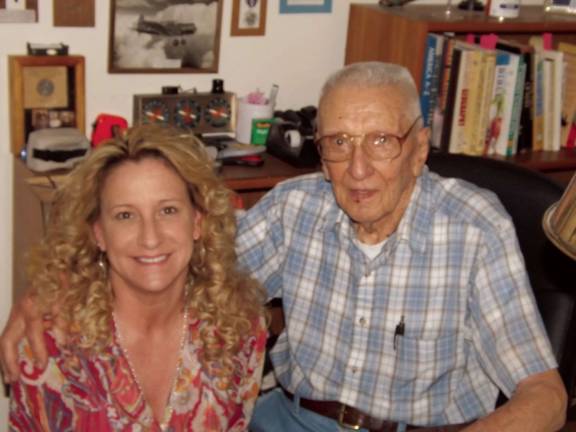A remembrance of D-Day

NEWTON — Lieutenant Colonel Henry Supchak has a story to tell, a story of courage, of wisdom, of leadership, and survival.
Thanks to his daughter Elizabeth Hoban, his experiences as a bomber pilot and a prisoner of war during the Second World War are available for all to read in his book "The Final Mission: a Boy, a Pilot, and a World at War," published by Westholme Publishing, LLC.
Now 97 years old, Col. Supchak spent most of his young adult life in military service. He was born and raised in Nanticoke, Pennsylvania.
With jobs scarce in the 1930s, Supchak joined the Navy and served four years, mostly in the Pacific. He had returned to civilian life, but after the Japanese attack on Pearl Harbor on December 7, 1941, he volunteered for the United States Army Air Corps and qualified as a bomber pilot. He flew the B17, known as the Flying Fortress.
On June 6, 1944 — D-Day — he and his crew, and their aircraft named Priority Galwere assigned to bomb German gun emplacements about 20 miles south of the Omaha Beach landing site. Supchak recalls, “At eight thousand feet we had a panoramic view of all the activity along the beach.” He writes, “It was the saddest sight to behold...There were so many men who never even made it out of the water. There wasn’t a dry eye on the plane during that mission, and it was a silent and solemn return flight back to England. It’s the stuff nightmares are made of.” To this day, Supchak has nightmares about the horrors of that morning.
About six weeks later, the Priority Gal was flying its 33rd mission, a bombing raid on Munich, when they encountered heavy anti-aircraft fire, which crippled their aircraft. Supchak ordered his crew to put on their parachutes and bail out, leaving him alone to bring the B17 down. He was headed straight for the village of Neustift, where the crash and explosion would have destroyed the town and the civilians who lived there. Supchak made a sharp turn, diverting the plane’s flight path away from the village, and at the last minute he bailed out.
On the ground a six-year-old boy, Ander Haas, and his aunt were tending sheep and watched as Supchak saved their village from becoming collateral damage. Even so, the Priority Gal’s crash destroyed their sheep shearing hut; Ander and his aunt suffered burns from falling fragments of the B17. But they were alive, and they knew right away that the American pilot whom they had seen parachuting from the aircraft was responsible for saving their lives and the lives of hundreds of their neighbors.
Col. Supchak was taken prisoner by the SS and held in an outpost outside of town. Ander and his aunt managed to smuggle water, bread, and cheese to him for several days. Supchak writes, “The boy saved my life. It was that simple.”
Supchak and his crew were transferred to the custody of the Gestapo and imprisoned in StalagLuft III with thousands of other American, British, and Australian prisoners. Conditions were difficult, and escape was nearly impossible. The previous year, 78 British prisoners had managed to dig a tunnel and get out — an accomplishment immortalized in the film "The Great Escape." However, 75 of them were recaptured, and all 75 were summarily executed on recapture.
On April 29, they woke to the sound of heavy gunfire, explosions, and the distinctive rumbling of tanks. Tanks rumbled over the barbed wire, and then a convoy of jeeps came through. In the lead jeep was an officer wearing a silver helmet with three stars. It was General George S. Patton.
He gave a simple glance as an order to cut down the German swastika flag and to raise the Stars and Stripes. Thousands of airmen, many not even Americans, fell to their knees in tears, knowing for the first time in many months the feeling of freedom. It was from General Patton’s lips that Supchak heard for the first time the words, “Thank you for your service.” Following the jeeps were trucks loaded with food: steamed rice, bananas, fresh bread, and tea, foods that malnourished prisoners of war would be able to digest.
In the years after the war, continued in military service, now in the newly-established United States Air Force. He married an army nurse who had served in a Mobile Army Surgical Hospital (MASH) unit in Korea.
They both retired from military service in 1956 and moved to New Jersey to raise a family. Meanwhile, Ander Haas grew up and became a successful hotelier in his native Austrian Tyrol.
He also made it a point to reunite with the American pilot who managed to divert his aircraft from crashing in his village.
Haas worked with a historian, Jakob Mayer, and in 2006 Mayer contacted Supchak to inform him that a monument had been erected in his honor in Neustift.
In 2007 Supchak traveled to Austria, accompanied by his daughter Elizabeth Hoban, to participate in the rededication of the monument.
Colonel Supchak is the last surviving member of the Priority Gal’s crew and, in fact, one of the last surviving World War II veterans.
Today, June 6, marks the 69th anniversary of D-Day, the invation of Normandy Beach in 1944.
"The Final Mission" is available on amazon.com